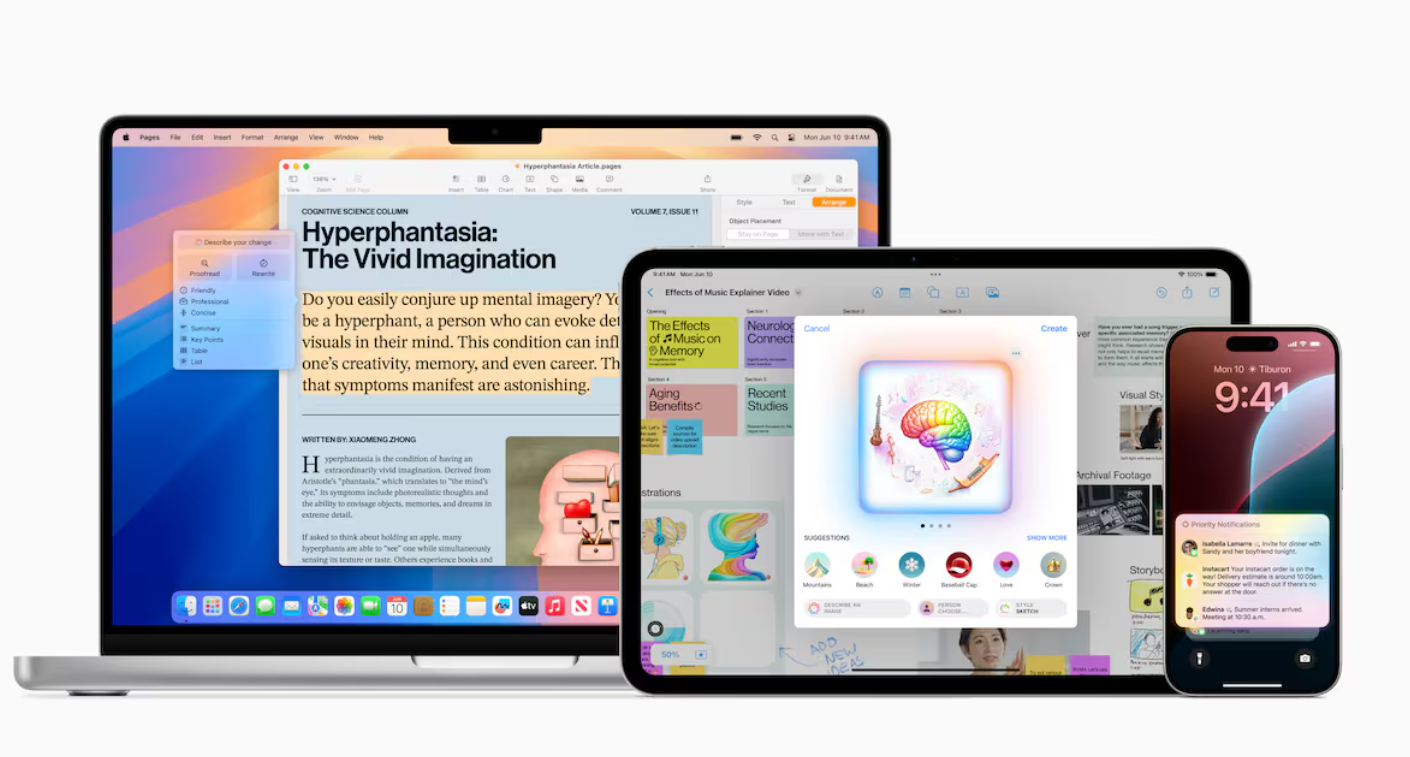
The new generative AI system, which is locked to iPhones and iPads for European users, will not be available in Spanish before spring 2025
Almost two years after the launch of ChatGPT, which revolutionized the technology industry in November 2022, Apple is launching its generative artificial intelligence (AI) system. With the software updates for its devices — iOS 18.1 and macOS 15.1, available since Monday — the new smart functions are now available. EL PAÍS has had access to them before the launch and has tested them thoroughly: they stand out for their convenience and ease of use, but they do not rival the spectacular capabilities that the competition has been launching during the current race to boost all kinds of technological tools with AI.
When Apple Intelligence took center stage at the annual software developers conference WWDC last June , the Californian tech giant billed it as a new form of “personal” rather than artificial intelligence. It touted the ability to understand personal context and combine it with generative AI models to provide intelligent features tailored to each user’s experiences, which Apple touts alongside sophisticated abilities to create unique images and emojis just by describing them.
None of these flagship features are available at the launch of the new artificial intelligence service: it takes off with a very small first package of new features , which carry the beta test label and are far from making Apple’s devices the smartest in their class. Most of these functions that are now coming to the latest iPhones – only to the 15 Pro, 16 and 16 Pro – have already been available for some time on recent smartphones from Google or Samsung and in Microsoft apps.
For now, only those who use their iPhones, iPads and Macs in US English will have access to Apple Intelligence. This artificial intelligence will be opened up to additional variants of English in the coming months, but it will not begin to reach other languages — including Spanish — until April 2025, Apple confirmed on Monday. In addition, in the European Union (EU) the system was blocked on Apple phones and tablets. And it will remain that way until next spring it is adapted to the corresponding community regulations, the so-called Digital Markets Act (DMA). In the meantime, unless you use an Apple account in the US — or one of the many other countries in which the company has activated its new AI without access restrictions — the only way to be able to test these new features in the EU from this Monday is by having a Mac computer with an M1 processor or higher and updating its operating system to macOS 15.1.
The tests carried out by this newspaper have therefore focused on the possibility of testing Apple Intelligence on computers. After carrying out this update, changing the language of the Mac – and of Siri – to US English, the option to request the activation of Apple Intelligence appears in Settings > Siri: then you enter a waiting list and in just a few minutes – at least, during the tests by EL PAÍS – you can already use the intelligent new features. The most notable feature of this first wave, while waiting for the most spectacular functions to arrive with new updates, are the writing tools, which allow you to correct, rewrite and summarise texts. They are available for now in Apple’s own apps such as Notes, Messages, Mail, Safari and also in other text editors such as Microsoft Word. To use these functions, simply select the text and choose the ‘Writing Tools’ option in the ‘Edit’ menu, which is also accessible in the quick menu that appears when you right-click on the text.
The first option you see is for proofreading and correcting texts . In tests, it suggests corrections appropriate to journalistic texts published in English by native speakers. However, it is still a new interface for checking spelling, punctuation and grammar that computers have had for decades. The new intelligence begins to become more evident and useful with the next option, for rewriting: it is useful both for fine-tuning the writing, making it clearer and more direct, and for writing a text in natural language from telegraphic sentences.
Writing with the help of AI
Unlike competing systems, the initial version of Apple Intelligence only allows you to choose three additional tones for this rewriting—friendly, professional, and concise—rather than being able to specify the tone with specific instructions about what the text is intended for. And for now, these AI-assisted writing tools also don’t allow you to compose a text from scratch based on instructions. Those two possibilities will arrive with the next package of intelligent innovations—in December, with the updates to iOS 18.2 and macOS 15.2—which will integrate ChatGPT for more sophisticated requests.
For now, a third function of the writing tools allows you to summarize text, both to shorten a text and to help with its reading and understanding. To summarize, there are three options: synthesize in a paragraph, in a bulleted outline, or in a table. In the days before Apple Intelligence was launched, the quality of these summaries varied between the different texts chosen for testing; and, as with other generative AI systems, in some cases hallucinations appear that can lead to striking misunderstandings.
The system, which has been in testing for a few months, allows users to evaluate the results and send feedback to Apple. The general impression is that these writing tools are a very practical aid to perfecting writing in a language (currently, only in US English), whether you are a native speaker or have a more limited ability to express yourself. Also, Apple’s clear and simple way of implementing them promises to bring generative AI to many users who are still on the sidelines of the technological revolution initiated by ChatGPT .
Other features that come with the launch of Apple Intelligence are smart replies in Messages and Mail, or automatic summaries of emails, messages, notifications, voice notes or calls. In the case of Safari, these summaries are especially practical and precise, and are offered when consulting web pages (only in English, for now) by activating reading mode. And in the Photos app, you can automatically delete objects or people or search for images by typing what you want to find. Again, in all these cases, nothing goes beyond what multiple apps and chatbots from other companies that use generative AI have already been offering.
Renew Siri without losing privacy
Apple has admitted, in a recent interview with its software vice president Craig Federighi , that the launch of Apple Intelligence is just a first step and that it will continue to expand the system little by little. According to Federighi, the priorities are more privacy and caution in order to implement this technology correctly and responsibly over the years, than catching up with its competitors in the AI race as soon as possible. The new features that the new system brings to the Siri voice assistant are another example of this multi-phase strategy.
For now, in this initial phase, Siri has a new look , it also responds to typed commands —not just spoken requests—, it is able to keep the thread of a chain of different questions and to understand the user if they get stuck speaking or change what they are saying in the middle of their question. In addition, the voice assistant can answer questions about Apple products; this is something that is useful to find out how to change computer settings, for example. However, the new, really smart Siri, which users have been asking for years, will not arrive until spring 2025. In addition to answering complex questions using ChatGPT, it will be then —with the updates to iOS 18.4 and macOS 15.4— when Siri will be able to understand personal questions that Apple already promotes in its ads , such as: “What time does my mother’s flight arrive?” or “What is the name of the person I had a meeting with at the Museum of Contemporary Art last month?”
To process these personal questions, Apple’s AI must use confidential information handled by apps on its computers, tablets and phones. The company maintains that, to protect privacy, processing will be done whenever possible on the device itself: in these cases, neither personal data – nor texts that can now be corrected, rewritten or summarized – will travel to servers like those used by OpenAI to process questions to ChatGPT. Only for the most complex tasks will the information be sent to the cloud. Apple has promised that, for this, the information will travel encrypted to its new Private Computing Cloud and will never be stored there. Last week, the technology giant announced that it has opened up this system so that independent researchers can check its security and that it will financially reward those who find vulnerabilities.
With the launch of Apple Intelligence, its use will begin on a large scale, with millions of users, which will really put to the test in the coming months both the reliability of Apple’s first generative AI tools and the privacy of those processes. In any case, the restricted scope of this system – for the moment, it will only work in US English; and it will never do so on phones prior to the iPhone 15 Pro – gives the technology multinational room to make improvements before starting to open it up in April 2025 to new languages such as Spanish, Chinese, French or Japanese. In addition to announcing this approximate date for the internationalization of its AI, the company has announced that it will also be next April when it will make its system comply with the European directive: only then, Apple’s so-called “personal intelligence” will reach users in the European Union who have a compatible iPhone or iPad .





